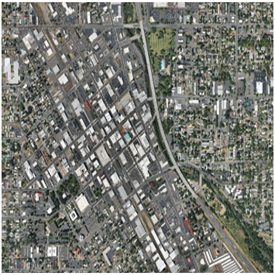
The topographical variations in the surface of the earth and the tilt of the camera affect the distance with which features on the aerial image are displayed. The more topographically diverse the landscape, the more distortion inherent in the photograph. As a result, real world distances are not represented uniformly on the photograph. For example, an inch measured in a steep area would relate to a much longer distance than an inch measured over a flat surface such as a plain.
Orthorectification is the process used to remove relief and tilt displacement. After removal of these distortions, correct ground positions and equilibrate photo units with real life distances can be obtained. Once an aerial photo has been Orthorectified, it is commonly referred to as an OrthoPhoto.
